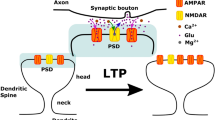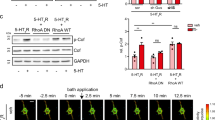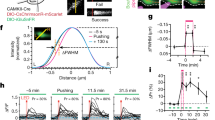Abstract
During development, dendrites, and in particular dendritic filopodia, undergo extensive structural remodeling, presumably to help establish synaptic contacts. Here, we investigated the role of calcium signaling in dendritic plasticity by simultaneously recording calcium dynamics and filopodial growth in rat hippocampal slice cultures. Local calcium transients occurred in dendritic filopodia and shafts, often at putative synaptic sites. These events were highly correlated with filopodial motility: comparatively rare when individual filopodia emerged from the dendrite, they became more frequent after filopodia started growing, finally causing them to halt. Accordingly, an experimental reduction of the frequency of local calcium transients elicited filopodial growth and, conversely, calcium uncaging reduced filopodial motility. Our observations suggest that low levels of local calcium transients facilitate filopodial outgrowth, whereas high levels inhibit the formation of filopodia and stabilize newly formed ones. This process may facilitate synapse formation and may serve as a homeostatic mechanism distributing synapses evenly along developing dendrites.
This is a preview of subscription content, access via your institution
Access options
Subscribe to this journal
Receive 12 print issues and online access
$209.00 per year
only $17.42 per issue
Buy this article
- Purchase on Springer Link
- Instant access to full article PDF
Prices may be subject to local taxes which are calculated during checkout






Similar content being viewed by others
References
Wong, W.T. & Wong, R.O. Rapid dendritic movements during synapse formation and rearrangement. Curr. Opin. Neurobiol. 10, 118–124 (2000).
Dunaevsky, A. & Mason, C.A. Spine motility: a means towards an end? Trends Neurosci. 26, 155–160 (2003).
Harris, K.M. Structure, development, and plasticity of dendritic spines. Curr. Opin. Neurobiol. 9, 343–348 (1999).
Jontes, J.D. & Smith, S.J. Filopodia, spines, and the generation of synaptic diversity. Neuron 27, 11–14 (2000).
Meberg, P.J., Kossel, A.H., Williams, C.V. & Kater, S.B. Calcium-dependent alterations in dendritic architecture of hippocampal pyramidal neurons. Neuroreport 10, 639–644 (1999).
Wu, G.Y., Deisseroth, K. & Tsien, R.W. Spaced stimuli stabilize MAPK pathway activation and its effects on dendritic morphology. Nat. Neurosci. 4, 151–158 (2001).
Lohmann, C., Myhr, K.L. & Wong, R.O. Transmitter-evoked local calcium release stabilizes developing dendrites. Nature 418, 177–181 (2002).
Ciccolini, F. et al. Local and global spontaneous calcium events regulate neurite outgrowth and onset of GABAergic phenotype during neural precursor differentiation. J. Neurosci. 23, 103–111 (2003).
Brunig, I., Kaech, S., Brinkhaus, H., Oertner, T.G. & Matus, A. Influx of extracellular calcium regulates actin-dependent morphological plasticity in dendritic spines. Neuropharmacology 47, 669–676 (2004).
Fink, C.C. et al. Selective regulation of neurite extension and synapse formation by the beta but not the alpha isoform of CaMKII. Neuron 39, 283–297 (2003).
Portera-Cailliau, C., Pan, D.T. & Yuste, R. Activity-regulated dynamic behavior of early dendritic protrusions: evidence for different types of dendritic filopodia. J. Neurosci. 23, 7129–7142 (2003).
Jourdain, P., Fukunaga, K. & Muller, D. Calcium/calmodulin-dependent protein kinase II contributes to activity-dependent filopodia growth and spine formation. J. Neurosci. 23, 10645–10649 (2003).
Korkotian, E. & Segal, M. Release of calcium from stores alters the morphology of dendritic spines in cultured hippocampal neurons. Proc. Natl Acad. Sci. USA 96, 12068–12072 (1999).
Korkotian, E. & Segal, M. Regulation of dendritic spine motility in cultured hippocampal neurons. J. Neurosci. 21, 6115–6124 (2001).
Koizumi, S. et al. Characterization of elementary Ca2+ release signals in NGF- differentiated PC12 cells and hippocampal neurons. Neuron 22, 125–137 (1999).
Dailey, M.E., Buchanan, J., Bergles, D.E. & Smith, S.J. Mossy fiber growth and synaptogenesis in rat hippocampal slices in vitro. J. Neurosci. 14, 1060–1078 (1994).
Dailey, M.E. & Smith, S.J. The dynamics of dendritic structure in developing hippocampal slices. J. Neurosci. 16, 2983–2994 (1996).
Fiala, J.C., Feinberg, M., Popov, V. & Harris, K.M. Synaptogenesis via dendritic filopodia in developing hippocampal area CA1. J. Neurosci. 18, 8900–8911 (1998).
Garaschuk, O., Hanse, E. & Konnerth, A. Developmental profile and synaptic origin of early network oscillations in the CA1 region of rat neonatal hippocampus. J. Physiol. (Lond.) 507, 219–236 (1998).
Missiaen, L., Callewaert, G., De Smedt, H. & Parys, J.B. 2-Aminoethoxydiphenyl borate affects the inositol 1,4,5-trisphosphate receptor, the intracellular Ca2+ pump and the non-specific Ca2+ leak from the non-mitochondrial Ca2+ stores in permeabilized A7r5 cells. Cell Calcium 29, 111–116 (2001).
Bootman, M.D. et al. 2-aminoethoxydiphenyl borate (2-APB) is a reliable blocker of store-operated Ca2+ entry but an inconsistent inhibitor of InsP3-induced Ca2+ release. FASEB J. 16, 1145–1150 (2002).
Capogna, M., Volynski, K.E., Emptage, N.J. & Ushkaryov, Y.A. The α-latrotoxin mutant LTXN4C enhances spontaneous and evoked transmitter release in CA3 pyramidal neurons. J. Neurosci. 23, 4044–4053 (2003).
Steward, O. & Falk, P.M. Selective localization of polyribosomes beneath developing synapses: a quantitative analysis of the relationships between polyribosomes and developing synapses in the hippocampus and dentate gyrus. J. Comp. Neurol. 314, 545–557 (1991).
Ben-Ari, Y., Cherubini, E., Corradetti, R. & Galarsa, J-L. Giant synaptic potentials in immature rat CA3 hippocampal neurones. J. Physiol. (Lond.) 416, 303–325 (1989).
Tyzio, R. et al. The establishment of GABAergic and glutamatergic synapses on CA1 pyramidal neurons is sequential and correlates with the development of the apical dendrite. J. Neurosci. 19, 10372–10382 (1999).
Hennou, S., Khalilov, I., Diabira, D., Ben-Ari, Y. & Gozlan, H. Early sequential formation of functional GABAA and glutamatergic synapses on CA1 interneurons of the rat foetal hippocampus. Eur. J. Neurosci. 16, 197–208 (2002).
Schuster, T. et al. Immunoelectron microscopic localization of the neural recognition molecules L1, NCAM, and its isoform NCAM180, the NCAM-associated polysialic acid, β1 integrin and the extracellular matrix molecule tenascin-R in synapses of the adult rat hippocampus. J. Neurobiol. 49, 142–158 (2001).
Spitzer, N.C. Activity-dependent neuronal differentiation prior to synapse formation: the functions of calcium transients. J. Physiol. (Paris) 96, 73–80 (2002).
Kang, H. & Schuman, E.M. Intracellular Ca2+ signaling is required for neurotrophin-induced potentiation in the adult rat hippocampus. Neurosci. Lett. 282, 141–144 (2000).
Zhang, S. & Murphy, T.H. Ca2+-independent spine dynamics in cultured hippocampal neurons. Mol. Cell. Neurosci. 25, 334–344 (2004).
Gomez, T.M., Robles, E., Poo, M. & Spitzer, N.C. Filopodial calcium transients promote substrate-dependent growth cone turning. Science 291, 1983–1987 (2001).
Robles, E., Huttenlocher, A. & Gomez, T.M. Filopodial calcium transients regulate growth cone motility and guidance through local activation of calpain. Neuron 38, 597–609 (2003).
Ziv, N.E. & Smith, S.J. Evidence for a role of dendritic filopodia in synaptogenesis and spine formation. Neuron 17, 91–102 (1996).
Niell, C.M., Meyer, M.P. & Smith, S.J. In vivo imaging of synapse formation on a growing dendritic arbor. Nat. Neurosci. 7, 254–260 (2004).
Stoppini, L., Buchs, P.-A. & Muller, D. A simple method for organotypic cultures of nervous tissue. J. Neurosci.Meth. 37, 173–182 (1991).
Kettunen, P. et al. Imaging calcium dynamics in the nervous system by means of ballistic delivery of indicators. J. Neurosci. Meth. 119, 37 (2002).
O'Brien, J.A., Holt, M., Whiteside, G., Lummis, S.C.R. & Hastings, M.H. Modifications to the hand-held Gene Gun: improvements for in vitro Biolistic transfection of organotypic neuronal tissue. J. Neurosci. Methods 112, 57–64 (2001).
Haas, K., Sin, W.C., Javaherian, A., Li, Z. & Cline, H.T. Single-cell electroporation for gene transfer in vivo. Neuron 29, 583–591 (2001).
Engert, F. & Bonhoeffer, T. Synapse specificity of long-term potentiation breaks down at short distances. Nature 388, 279–284 (1997).
Veselovsky, N.S., Engert, F. & Lux, H.D. Fast local superfusion technique. Pflugers Arch. 432, 351–354 (1996).
Diggle, P.J. Displaced amacrine cells in the retina of a rabbit: analysis of a bivariate spatial point pattern. J. Neurosci. Methods 18, 115–125 (1986).
Acknowledgements
We thank F. Siegel for performing data analysis; O. Momoh and N. Stöhr for preparation and maintenance of slice cultures; S. Eglen for help with the Monte Carlo statistics; and R. Wong and M. Hübener for critically reading the manuscript. This work was supported by the Max-Planck-Gesellschaft and the Schloessmann Foundation (C.L.).
Author information
Authors and Affiliations
Corresponding author
Ethics declarations
Competing interests
The authors declare no competing financial interests.
Supplementary information
Supplementary Fig. 1
Model for the regulation of filopodial growth by local calcium transients. (PDF 547 kb)
Supplementary Video 1
Local and global calcium transients. Local and global calcium transients in dendrites of a CA3 pyramidal neuron (real time). (MOV 614 kb)
Supplementary Video 2
Filopodial calcium transients. Three consecutive calcium transients are generated in a filopodium and spread into the dendritic shaft with some delay (3 x faster than real time). (MOV 408 kb)
Supplementary Video 3
Filopodial growth and calcium transients. Two filopodia grow during this recording. Calcium transients in the parent dendrite can be seen after the onset of growth, but not before (30 x faster than real time). (MOV 281 kb)
Rights and permissions
About this article
Cite this article
Lohmann, C., Finski, A. & Bonhoeffer, T. Local calcium transients regulate the spontaneous motility of dendritic filopodia. Nat Neurosci 8, 305–312 (2005). https://doi.org/10.1038/nn1406
Received:
Accepted:
Published:
Issue Date:
DOI: https://doi.org/10.1038/nn1406
This article is cited by
-
How filopodia respond to calcium in the absence of a calcium-binding structural protein: non-channel functions of TRP
Cell Communication and Signaling (2022)
-
Mice carrying a schizophrenia-associated mutation of the Arhgap10 gene are vulnerable to the effects of methamphetamine treatment on cognitive function: association with morphological abnormalities in striatal neurons
Molecular Brain (2021)
-
Differential dynamics of cortical neuron dendritic trees revealed by long-term in vivo imaging in neonates
Nature Communications (2018)
-
Intracellular Calcium Fluxes in Excitable Cells
Neurophysiology (2017)
-
TRPM7 Regulates Axonal Outgrowth and Maturation of Primary Hippocampal Neurons
Molecular Neurobiology (2016)



